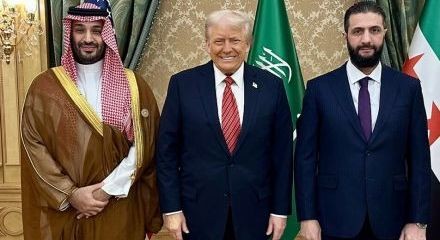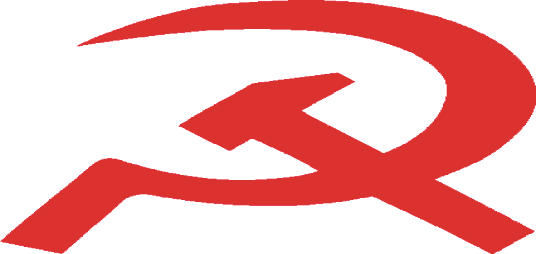29.05.2025

Kurdish entanglements
Laying down arms and dissolving the PKK has been hailed by some optimists as a ‘victory’. Yassamine Mather strongly disagrees and instead sees the defeat of the Kurdish people both in Turkey and Syria
In the years ahead, Trump’s May 2025 visit to the Middle East will be best remembered for a photo that captured a striking moment: he was standing between Saudi crown prince Mohammed bin Salman (widely held responsible for the brutal murder and dismemberment of journalist Jamal Khashoggi) and Syria’s new ‘interim’ president, Ahmad al-Sharaa (a former jihadi commander who, until only months earlier, featured on the US ‘terrorist’ list). Of course, if you think this is strange, remember that “it took 20 years, trillions of dollars and four US presidents to replace the Taliban with the Taliban”.1
In the Middle East, al-Sharaa’s political and ideological roots, combined with Turkey’s open backing of his regime, have created new regional realities, forcing Israel and other actors to reassess their positions concerning Syria. Here there are indications of an increasing rivalry between Turkey and Israel. Though the two governments have not yet clashed directly on Syrian territory or elsewhere, their diverging interests appear to be steering them towards behind-the-scenes contests.
The new Syrian president is a Sunni with an Islamist political and ideological background. He was a good choice from the point of view of Turkey, which has been an active supporter of the Syrian opposition factions since the civil war erupted in 2011. As soon as Hayat Tahrir al-Sham came to power in Damascus, Turkey threw its weight behind the new regime. Although the Israeli government played a significant role in the overthrow of the Assad regime and had some previous cooperation with HTS, it is wary of al-Sharaa. It considers him a potential risk, especially given his jihadist past and regional affiliations.
Israeli ops
Israel has intensified its ground operations in southern Syria in recent months, while simultaneously carrying out air strikes across the country - targeting areas from Latakia and Homs to the outskirts of Damascus. Israel claims its attacks are meant to stop weapons from reaching Syria’s new government, even though HTS has shown no signs of seeking conflict with Israel.
Ultimately Israel aims to occupy and control southern Syria. By intensifying ground incursions and targeting Syrian government and allied forces, the Zionist state is trying to establish a de facto buffer zone, claiming such a move is necessary to “protect its northern border”. At the same time, Israel is seeking to deepen its security arrangements with Turkey beyond existing understandings - and with Russia, as part of a broader strategy to share responsibilities in Syria. For Israel, one concern is that Turkey’s growing military presence, especially its control of airspace, could limit Israel’s operational freedom, particularly in confronting Iranian influence.
That might explain why Israel’s posture toward Turkey has fluctuated between cooperation and confrontation, indicating a level of ambivalence about whether their interests align or diverge. Turkey’s intervention in Syria has never made a claim of extending Turkish-style ‘democratic Islamism’: instead it is more concerned with its ‘Kurdish question’.
Historically, Turkey has cultivated good relationships with Saudi Arabia and Qatar, while keeping close ties with the United States and Nato to compete with Israel as a regional power. Meanwhile, Israel has strengthened ties with the Kurds - particularly amid tensions between Damascus and the Syrian Democratic Forces - and has also reached out to Syria’s Druze community (so far unsuccessfully).
Such engagements are not just tactical: they reflect a deeper commitment to gain new, long-standing regional partners, especially at a time when the Zionist state faces charges of genocide and ethnic cleansing of Palestinians.
No doubt Turkey and Israel have different visions for Syria’s future. Israel aims to integrate Syria into the Abraham Accords and normalise its status in line with its security and diplomatic goals. Turkey envisages a unified Islamic Syria ideologically aligned with Ankara - a vision Israel views as a threat. To counter this, it is likely to empower ethnic and sectarian minorities - not only to promote decentralisation, but to encourage fragmentation.
What are Turkey’s other aims in Syria? On May 12, the Kurdistan Workers Party (PKK), which has waged a four-decade-long insurgency against Turkey, announced its decision to lay down arms and dissolve the organisation. This development follows a February call from the group’s imprisoned leader, Abdullah Öcalan.
On May 15, Reuters reported that during a press conference at an informal meeting of Nato foreign ministers in Antalya, Turkish foreign minister Hakan Fidan stated that Ankara expects the Kurdish-led Syrian Democratic Forces - a PKK affiliate - to comply with agreements made with Damascus, particularly after the PKK announced its dissolution and disarmament. In fact, since the PKK’s announcement, the SDF has moved towards integrating with Syrian state institutions. In March 2025, it reached an agreement with the government to integrate, though details are still being worked out. This agreement aims to bring the SDF, which controls much of north-eastern Syria, under the Syrian government’s jurisdiction.
The SDF - a Kurdish-led alliance primarily composed of the People’s Protection Units (YPG) - alongside Arab, Assyrian and other militias, has been widely portrayed - especially in the western media - as a secular, democratic and progressive force. However, there are reasons to doubt that.
Eight reasons
1. While the SDF and its political wing, the Syrian Democratic Council, claim to support democratic confederalism, critics argue that this model is unevenly applied, especially outside majority-Kurdish areas. In Arab-majority areas like Raqqa and Deir ez-Zor, critics - including Arab activists - have accused the SDF of Kurdish domination, marginalising local populations and failing to build truly representative governance. The appointment of councils and ‘local governance’ structures in some regions is often top-down, not genuinely democratic or popular.
2. This supposed ‘democratic’ organisation is still very much under the influence of a single permanent leader: namely Abdullah Öcalan.
3. The SDF has relied heavily on US military support, particularly during the campaign against Islamic State. This has made it strategically dependent on American interests, which can undermine claims of full autonomy or anti-imperialism. By acting as a proxy force for the US, against both IS and, indirectly, the Assad government and Iranian influence, the SDF’s role fits within broader US regional strategy, which has nothing to do with revolutionary politics, even though both IS and Iran are reactionary regional forces.
4. From a Marxist or anti-imperialist standpoint, the SDF’s collaboration with US imperialism is often seen as deeply compromising, no matter how ‘progressive’ its internal policies might appear. The fetishisation of the Rojava region by some western leftist fans has led to a lack of critical engagement with these contradictions - especially the role of US military logistics, bases and intelligence support.
5. Arab populations in eastern Syria have accused the SDF of discrimination, arbitrary arrests and repression. Reports from human rights organisations and local activists have documented forced conscription, including of minors, in both Kurdish and Arab areas. Despite public commitments to end the practice, the SDF has been repeatedly accused of forcibly recruiting minors. An incident this month involved the abduction of 14-year-old Asaad Mustafa Ali by the Revolutionary Youth (Jwanen Shorshkar), an SDF-affiliated group. Another 2023 UN report highlighted that over half of the documented child recruitment cases in Syria occurred in SDF-controlled areas.2
6. While the leadership is multi-ethnic in appearance, real power is often seen as being concentrated in the hands of the Kurdish PYD/YPG cadre, which operate with their own ideological and military agenda.
7. In some areas, especially because of its post-IS campaigns, the SDF has been accused of population displacement, collective punishment and property confiscation. The destruction of Arab-majority villages and the limited return of displaced populations have led to accusations of ethnic engineering or demographic manipulation in favour of Kurdish control.
8. Arbitrary detentions and the suppression of dissent, when it comes to journalists as well as civilians. The Syrian Network for Human Rights reported over 2,600 arbitrary detentions in 2024. Furthermore, the SDF has been accused of suppressing dissenting voices, with the continued detention of people for expressing their opinions.3
The dissolution of the PKK and the SDF’s agreement with the Syrian government are hailed by some optimists as a ‘victory’. I strongly disagree with that assessment. In reality, the repeated strategic missteps of both organisations have once again resulted in a defeat - not only for the Kurdish people, but also for the broader left in the region.
